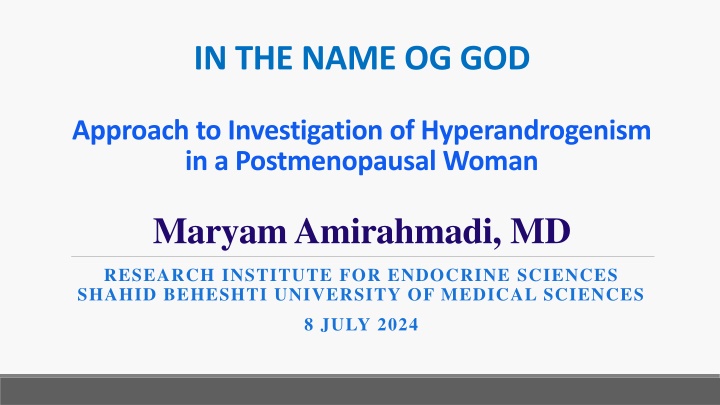IN THE NAME OG GOD
Investigation of hyperandrogenism in postmenopausal women involves a comprehensive evaluation of symptoms, hormonal levels, and possible underlying conditions. This case study outlines a detailed examination process, including gynecological assessments, lab data analysis, and histopathological findings in a postmenopausal woman presenting with androgen-dependent symptoms. The management of hyperandrogenism post-hysterectomy is also discussed, highlighting the importance of multidisciplinary care and monitoring postoperative outcomes.
Download Presentation

Please find below an Image/Link to download the presentation.
The content on the website is provided AS IS for your information and personal use only. It may not be sold, licensed, or shared on other websites without obtaining consent from the author.If you encounter any issues during the download, it is possible that the publisher has removed the file from their server.
You are allowed to download the files provided on this website for personal or commercial use, subject to the condition that they are used lawfully. All files are the property of their respective owners.
The content on the website is provided AS IS for your information and personal use only. It may not be sold, licensed, or shared on other websites without obtaining consent from the author.
E N D
Presentation Transcript
IN THE NAME OG GOD Approach to Investigation of Hyperandrogenism in a Postmenopausal Woman Maryam Amirahmadi, MD RESEARCH INSTITUTE FOR ENDOCRINE SCIENCES SHAHID BEHESHTI UNIVERSITY OF MEDICAL SCIENCES 8 JULY 2024
AGENDA Case presentation Menopausal Transition and Circulating Testosterone Etiology of Hyperandrogenism in Postmenopausal Women Evaluation Treatment
Case presentation A postmenopausal 66-year-old nulliparous woman with type 2 diabetes and hyperlipidemia She is being referred to a specialist clinic at a university hospital due to suspected androgendependent hair loss that has developed over the years. frontotemporal baldness and has been using a wig for a couple of years. The woman first sought medical help many years ago but was told that it is normal with hair loss after menopause. she is overweight with body mass index (BMI) 29 and she has abdominal fat distribution she has so-called Hippocratic baldness, corresponding to grade III on the Ludwig scale, oily skin, increased body hair, and blood pressure 160/90 mmHg.
Case presentation Gynecological examination; clitoromegaly and a greatly enlarged uterus on palpation, as well as bilateral ovaries of significant size detected by transvaginal ultrasound. She is referred for a Doppler ultrasound examination, which confirms large uterine fibroids and enlarged ovaries with normal blood flow. The patient undergoes hysterectomy and bilateral salpingo- ophorectomy.
Case presentation Histopathological examination reveals benign uterine fibroids and bilateral ovarian stromal hyperplasia with the presence of nests of luteinized theca cells, in agreement with ovarian hyperthecosis. There are no signs of malignancy. Postoperatively, testosterone levels normalize within a couple of weeks (0.8 nmol/L). The symptoms subside spontaneously, resulting in weight loss, and reduced abdominal obesity, hirsutism, and oily skin. However, androgenic alopecia and clitoromegaly remain.
Menopausal Transition and Circulating Testosterone Menopausal transition is associated with a decrease in the number of antral follicles and ovarian volume, as well as a decline in serum antim llerian hormone (AMH) as a marker for antral follicle count and ovarian reserve. When the number of antral follicles and ovarian granulosa cells decrease, estradiol levels decline and follicle-stimulating hormone (FSH) levels increase. Menopause, the last spontaneous menstruation, occurs on average at age 51 years when circulating estradiol has decreased to a level insufficient to stimulate the endometrium to grow and then shed. During this period, menopausal symptoms, including hot flushes, sweating, and sleep problems, are common and associated with the gradual decline in estradiol.
Menopausal Transition and Circulating Testosterone In contrast to the decrease in estradiol, circulating levels of testosterone decline as a consequence of age-related, but not menopause-related, reductions in secretion by both the adrenal gland and the ovary. This means a 50% reduction in testosterone in women aged 40-45 compared with women in the 18-24 age group. In premenopausal women, about 50% of circulating testosterone arises from direct secretion from the ovary and the adrenal gland The remaining 50% of testosterone is produced from peripheral conversion by ovarian and adrenal inactive androgen precursors In postmenopausal women, a larger part of these active androgens is synthesized in peripheral tissue
Menopausal Transition and Circulating Testosterone It was recently demonstrated that the androgen derivates 11-ketotestosterone and 11-ketodihydrotestosterone from the adrenal glands are also potent agonists of the human androgen receptor In contrast to classical androgens (DHEA, DHEAS, A4, and testosterone), 11-keto androgens do not decrease with age. Furthermore, these androgens have shown to be predominant in several disorders of hyperandrogenism, including polycystic ovary syndrome (PCOS) and congenital adrenal hyperplasia (CAH). determination of 11-keto androgens is not yet available as a clinical routine method.
Menopausal Transition and Circulating Testosterone Around 65% to 70% of circulating testosterone is bound and inactivated by SHBG, 30% to 35% is loosely bound to albumin, and only 0.5% to 3% represents freely circulating testosterone. Since the binding of testosterone to albumin is rather weak, the free and albumin- bound fractions are defined as bioavailable testosterone. The ratio of total testosterone to SHBG multiplied by 100 (the free androgen index) is used as a measure of circulating free testosterone. However, this measure is less relevant when total testosterone is pathologically increased. During menopausal transition, ovarian theca cell production of testosterone decreases due to follicle depletion, but this loss is compensated by increased LH stimulation of stroma cell production of testosterone.
Menopausal Transition and Circulating Testosterone Consequently, ovarian androgen production does not change significantly in relation to menopause. At the same time, SHBG decreases due to the decrease in ovarian estrogen production, and subsequently the free androgen index increases. Overall, this will result in a physiological shift from estrogen dominance to a relative predominance of androgens during menopausal transition. Besides the typical menopausal symptoms, it is not uncommon for healthy postmenopausal women to experience androgen-dependent symptoms, such as increased facial hair growth and hair thinning due to relative androgen excess.
Etiology of Hyperandrogenism in Postmenopausal Women Polycystic Ovary Syndrome PCOS is considered the most frequent endocrine disorder in women of reproductive age with a prevalence between 8% and 13% depending on diagnostic criteria and population studied. According to the Rotterdam criteria, at least 2 of the following 3 criteria are required for a diagnosis: oligomenorrhea or amenorrhea; biochemical or clinical hyperandrogenism such as hirsutism and acne polycystic ovarian morphology. There are no specific criteria to diagnose PCOS after menopause. The Endocrine Society Clinical Practice Guideline has therefore suggested that a diagnosis of PCOS in a postmenopausal woman can be based upon a history of oligo/amenorrhea and hyperandrogenism during the reproductive years.
Polycystic Ovary Syndrome The reproductive phenotype of PCOS usually improves by age due to loss of ovarian follicles, leading to more regular cycles and decreased ovarian volume .However, the decrease in ovarian volume and serum AMH during menopausal transition may be relatively less in women with PCOS than in other women. Consequently, the average age of menopause is approximately 2 years later in PCOS than in healthy controls. As androgen levels gradually decrease by age, symptoms of hyperandrogenism like hirsutism may improve in women with PCOS. The prevalence of hirsutism was significantly higher in postmenopausal women with PCOS than in control women (33% vs 4%) at mean age 81 years in a Swedish long-term follow-up study .
Polycystic Ovary Syndrome PCOS is considered a relatively mild form of hyperandrogenism since circulating levels of testosterone usually are within the upper normal female range, whereas SHBG is low, resulting in increased levels of free and bioavailable testosterone. Today, liquid chromatography-tandem mass spectrometry (LC MS/MS) is recognized as the gold standard method for testosterone determination in serum compared with immunobased clinical methods Available measurements based on LC MS/MS indicate that the normal range of testosterone in premenopausal women is 0.1 to 1.8 nmol/L, whereas the upper limit in women with PCOS is 3.1 nmol/L (95% CI one-sided). Although testosterone levels decline with increasing age, most studies have shown higher testosterone levels in postmenopausal women with PCOS than in control women. testosterone levels in postmenopausal women with PCOS seldom exceed 2 nmol/L
Polycystic Ovary Syndrome PCOS is a metabolic disorder with obesity Abdominal obesity is associated with insulin resistance hyperinsulinemia inhibition the hepatic synthesis of SHBG free androgen index In the long run, PCOS is associated with an increased risk of type 2 diabetes and metabolic syndrome, whereas the risk of cardiovascular disease seems not to be increased after menopause. Although hirsutism may be severe in PCOS, virilizing symptoms including clitoral enlargement are not associated with PCOS.
Ovarian Hyperthecosis Ovarian hyperthecosis is a relatively rare disorder presenting with slow progress of severe symptoms of hyperandrogenism in a perimenopausal or postmenopausal woman. It is likely the second most frequent cause of hyperandrogenism in postmenopausal women. The prevalence of ovarian hyperthecosis was reported to be 9.3% in postmenopausal women undergoing investigation for symptoms of androgen excess. The condition is often described as an extreme form of PCOS. In contrast to PCOS, ovarian hyperthecosis will progress into virilizing symptoms, including severe hirsutism, androgenic alopecia, deepening of the voice, breast atrophy, and clitoromegaly.
Ovarian Hyperthecosis In addition, the ovaries are bilaterally clearly enlarged with a volume up to 10 cm3, compared with a volume between 1 and 5 cm3 of a normal postmenopausal ovary in women with or without PCOS Ovarian hyperthecosis is strongly associated with metabolic symptoms, including abdominal obesity, hypertension, hyperlipidemia, insulin resistance, and acanthosis nigricans, in other words, the metabolic syndrome and type 2 diabetes.
Ovarian Hyperthecosis The metabolic symptoms are often more severe than in women with PCOS. Due to peripheral conversion of androgens to estrogens via aromatase, women with ovarian hyperthecosis also have an increased risk of endometrial pathology, including polyps, hyperplasia, and cancer, as well as breast cancer. Ovarian hyperthecosis is caused by nests of luteinized theca cells in the ovarian stroma producing high amounts of testosterone, Serum testosterone is usually increased above 5 nmol/L which distinguishes this condition from PCOS. The etiology of ovarian hyperthecosis is not known, although a genetic disposition and association with PCOS have been suggested.
Ovarian Hyperthecosis Several mechanisms behind the increased testosterone production have been proposed. One is related to the 2-cell hypothesis where ovarian testosterone production by theca cells is uncovered in a postmenopausal woman by the loss of granulosa cell mediated aromatization of testosterone to estradiol. Another mechanism involves increased gonadotrophin stimulation by elevated levels of LH after menopause. Thirdly, there is support that insulin resistance and hyperinsulinemia may induce stromal luteinization causing androgen overproduction. The most important differential diagnosis for ovarian hyperthecosis is an androgen-producing tumor, which can be malignant. In both cases, the patient has virilizing symptoms, but progress is usually slow for ovarian hyperthecosis but rapid for an androgen-producing tumor. In addition, testosterone is greatly elevated (>5 nmol/L) in both disorders, but mostly higher in women with an androgen-producing tumor than in those with ovarian hyperthecosis
Ovarian Hyperthecosis Furthermore, other androgens are usually not elevated in ovarian hyperthecosis, whereas androgen-producing adrenal tumors are associated with high levels of DHEAS and A4, and ovarian tumors with high levels of inhibin B. Almost all women with ovarian hyperthecosis have obesity and insulin resistance, but this is not the case of women with an androgen-producing tumor. Ovarian hyperthecosis is also characterized by bilateral increase in ovarian stroma, whereas an ovarian tumor usually presents as a unilateral enlargement. Still, it can be difficult to distinguish ovarian hyperthecosis from an androgenproducing tumor. The diagnosis of ovarian hyperthecosis is therefore confirmed by histopathology.
Androgen-Secreting Ovarian Tumors Androgen-secreting ovarian tumors originate from sex cord stroma and include Sertoli cell tumors, Sertoli Leydig cell tumors, Leydig cell tumors, thecoma, and granulosa cell tumors. These tumors are predominantly benign and occur at any age, but approximately 25% present after menopause. Together they comprise 5% to 8% of all ovarian neoplasms. The presentation is often rapid progress of clinical manifestations of excessive androgen and/or estrogen production. Androblastomas are those primarily secreting androgens, while thecoma and granulosa cell tumors mainly secrete estrogens, which can lead to postmenopausal bleeding, endometrial hyperplasia, or cancer. around 10% of granulosa cell tumors secrete androgens and may cause virilization The prevalence of an androgen-secreting ovarian tumor in postmenopausal women with symptoms of hyperandrogenism has been reported to be 2.7% Ovarian tumors are often small but can be identified using transvaginal ultrasound with color Doppler or magnetic resonance imaging (MRI). Asymmetry of the ovaries may suggest a tumor.
Androgen-Secreting Adrenal Tumors Androgen-secreting adrenal tumors are less common than the corresponding ovarian tumors. Adrenocortical carcinomas, are usually highly malignant tumors, and approximately 25% of cases are associated with severe symptoms of hyperandrogenism leading to virilization. The incidence is 1 to 2 cases/million population per year. There is a bimodal age distribution, with peaks before the age of 5 and in the fourth and fifth decade of life. DHEAS concentrations are often more than twice the upper limit, and a value above 19 mol/L is an indication for further evaluation. Adrenal tumors are best visualized by computed tomography (CT) as a unilateral mass. Adenomas are usually small, 2 to 2.5 cm, whereas adrenocortical carcinomas are larger, between 4 and 21 cm .
Nonclassical Congenital Adrenal Hyperplasia In contrast to classic CAH, women with NC CAH are usually diagnosed later in life due to mild symptoms of androgen excess, such as hirsutism, menstrual disorders, and infertility. The symptoms are very similar to PCOS, and, in agreement with PCOS, NC CAH is not associated with virilizing symptoms. Since some of these women may be undiagnosed or have worsening symptoms by age, NC CAH should be considered in postmenopausal women with hyperandrogenism. The NC form of CAH is estimated to be one of the most common autosomal recessive disorders, with a prevalence of 1% to 10% in women with hyperandrogenic symptoms. Elevated serum 17-OHP is indicative of CAH. It should be further investigated by an ACTH stimulation test. Serum concentrations of testosterone and adrenal androgen precursors (A4, DHEA, and DHEAS) are also increased. The diagnosis is confirmed by genetic testing and detection of a mutation causing enzyme deficiency and impaired corticosteroid synthesis.
Cushing Syndrome The overall incidence of Cushing syndrome is estimated to be 1.8 to 3.2 cases per million population. Cushing disease occurs mainly in women aged 25-45 years. The major clinical manifestations of Cushing syndrome are moon face and facial plethora, abdominal obesity, striae, buffalo hump, proximal muscle weakness, bruising, hypertension, glucose intolerance, depression, and other neuropsychological symptoms. About 50% of women with Cushing syndrome also have symptoms of hyperandrogenism, such as hirsutism, due to adrenal androgen excess (A4, DHEA, and DHEAS) The free androgen index is increased by endogenous hypercortisolism, probably due to a decrease in SHBG. However, signs of hyperandrogenism are usually mild to moderate and seldom lead to virilization
Iatrogenic Iatrogenic causes of hyperandrogenism due to overuse or abuse of androgenic drugs should be considered. Systemic testosterone and DHEA treatment of hypoactive sexual desire disorder or other androgen deficiency related symptoms in postmenopausal women may lead to overtreatment Treatment with the antiepileptic drug valproic acid has been shown to increase the risk of a PCOS-like phenotype in epidemiological studies. The mechanism is attributed to direct stimulation of ovarian androgen production by valproic acid. The anabolic steroid danazol, previously used for treatment of endometriosis and still used as therapy for hereditary angioedema, has been reported to induce hirsutism. It is well known that anabolic steroids can cause virilization in women when abused
Evaluation Clinical Symptoms Late onset and rapid development of virilizing symptoms suggest a hormone-producing tumor, whereas slow development of virilizing symptoms in a perimenopausal or postmenopausal woman is typical of ovarian hyperthecosis. In contrast, early symptom onset and slow progression of mild to moderate hyperandrogenic symptoms are more consistent with PCOS or another endocrine disorder (Fig. 3). Hirsutism is defined as excessive facial and body terminal hair in androgen-dependent body areas. Evaluation of hirsutism can be assessed by the modified Ferriman Gallwey score, A cut-off score of to indicate hirsutism, depending on ethnicity. However, this method has not been validated in postmenopausal women. 4 to 6 on the modified Ferriman Gallwey was suggested Androgenic alopecia, or female pattern hair loss, is characterized by thinning of hair in the frontoparietal region of the scalp. The disorder is dependent on androgens, particularly DHT, and 5 reductase activity in hair follicles. Hair loss on the scalp can be assessed using the Ludwig scale. Clitoromegaly is probably the most recognizable sign of virilization. It has been defined as 1.5 clitoromegaly must be carefully investigated, as they are easy to miss, especially in an obese woman. Other signs of virilization may be breast atrophy and severe hirsutism 2.5 cm. However, signs of
Women with virilizing symptoms No cut-off value of testosterone has been proposed for discriminating between a hormone- producing tumor and ovarian hyperthecosis. The next step is therefore to proceed with diagnostic imaging. Ovarian hyperthecosis is typically associated with an isolated increase in testosterone, while other androgens usually are within the reference values, see the patient case above. Insulin resistance is characteristic for ovarian hyperthecosis and therefore fasting insulin and glucose or HbA1c should be considered. In the case of hormoneproducing ovarian tumors, hormones other than testosterone may also be elevated, including inhibin B, AMH, A4, 17-OHP, and estradiol, whereas DHEAS and cortisol are normal
Women with virilizing symptoms The gonadotropin-releasing hormone (GnRH) agonist test can be used for distinguishing androgen-producing ovarian and adrenal tumors and successfully confirm an ovarian source from an adrenal source by suppression of testosterone. The test cannot differentiate between ovarian hyperthecosis and an ovarian tumor.
Imaging Transvaginal ultrasound is used to investigate a possible ovarian cause of hyperandrogenism, primarily an androgen-producing ovarian tumor. The mean size of a normal postmenopausal ovary is estimated to be 2.2 0.01 cm3 An ovarian tumor can be very small and difficult to identify, but asymmetry of the ovaries could be suggestive of such a tumor. Color Doppler ultrasound can identify a hypervascularized region, suggesting a tumor. Failure to identify a tumor with ultrasound does not rule out this possibility; MRI Ovarian hyperthecosis: average ovarian volume may be up to 10 cm3 Postmenopausal women with PCOS usually have larger ovaries than control women, although significantly less than 10 cm3
Imaging MRI has shown a higher positive and negative predictive value (78%) and (100%), respectively, for detection of an androgen-secreting ovarian tumor than transvaginal ultrasound. In addition, good sensitivity (83%) and specificity (80%) were reported for MRI in differentiating between virilizing ovarian tumors and ovarian hyperthecosis. CT is the preferable imaging technique for detecting adrenal tumors; it will detect nodules 5 mm
Treatment An ovarian source of androgen excess (ovarian tumor, ovarian hyperthecosis); laparoscopic bilateral oophorectomy, with or without hysterectomy. When a patient is not a suitable candidate for surgery; treatment with GnRH analogs. The primary treatment for androgen-secreting adrenal tumors is adrenalectomy
Treatment PCOS with persistent or hyperandrogenic symptoms are treated with antiandrogen therapy androgen receptor blockers (spironolactone, cyproterone acetate, flutamide) 5 reductase inhibitor (finasteride) treatment of metabolic symptoms with metformin Postmenopausal women with NC CAH are usually treated with antiandrogens, similarly to PCOS, and cortisone is seldom needed.
Conclusion Onset of symptoms, development, and severity of symptoms are indicative for further investigation. Testosterone 5 nmol/L is associated with virilizing symptoms and should prompt further investigation with imaging modalities to rule out an androgen-producing tumor. There is no discriminatory method to distinguish an ovarian hormone producing tumor from ovarian hyperthecosis, although the latter is related to slower development of virilizing symptoms and bilateral ovarian enlargement. Surgery with bilateral oophorectomy or removal of an adrenal tumor is the main curative treatment and will ultimately lead to a histopathological diagnosis. GnRH analogs can be used as an alternative treatment of ovarian hyperthecosis.
Conclusion PCOS is probably the most common cause of mild to moderate symptoms of hyperandrogenism and testosterone 5 nmol/L in postmenopausal women. In this case, the recommended treatment is antiandrogen therapy using an androgen receptor blocker and/or a 5 reductase inhibitor. NC CAH could be treated in a similar way or if needed with cortisone, whereas Cushing syndrome is primarily treated with surgery























